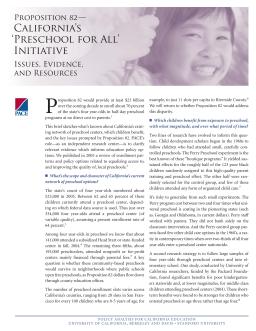School Finance and Governance in California
Published
Summary
Getting Down to Facts is an extensive investigation of CA's public education system commissioned by a bipartisan group of CA leaders. The project aimed to describe California's school finance and governance systems, identify obstacles hindering resource utilization, and estimate costs to achieve student outcome goals. The project resulted in 23 reports by scholars, which highlight that the current school finance and governance systems fail to help students achieve state performance goals, particularly those from low-income families. The reports provide a framework for assessing reform options.
Issues, Evidence, and Resources
Published
Summary
This brief provides an overview of California's existing network of preschool centers and the potential impact of Proposition 82, which would provide funding for half-day preschool programs for 70% of the state's four-year-olds. PACE, an independent research center, aims to clarify evidence informing education policy options. A 2005 PACE review focused on enrollment patterns and policy options for improving access and quality of local preschools.
California Families Face Gaps in Preschool and Child Care Availability
Published
Summary
This report highlights the unequal distribution of preschool and childcare opportunities in California. Despite spending $1.2 billion annually, half of preschool-age children live in households with working mothers, with enrollment dependent on income and location. Counties vary greatly in their supply, with affluent parents more likely to find preschool or childcare slots. Latino children are hit hardest, even in counties with ample supply, with supply in predominantly Latino areas half that of low-income Black or Anglo communities.
Published
Summary
School finance has become a prominent issue again due to court decisions and litigation in several states. This article explores school finance changes in the 70s and 80s and outlines key issues for the 90s, including the relationship between finance and education goals, site-based management, teacher pay, accountability, school choice, and nontraditional issues such as preschool and non-educational services for children.



